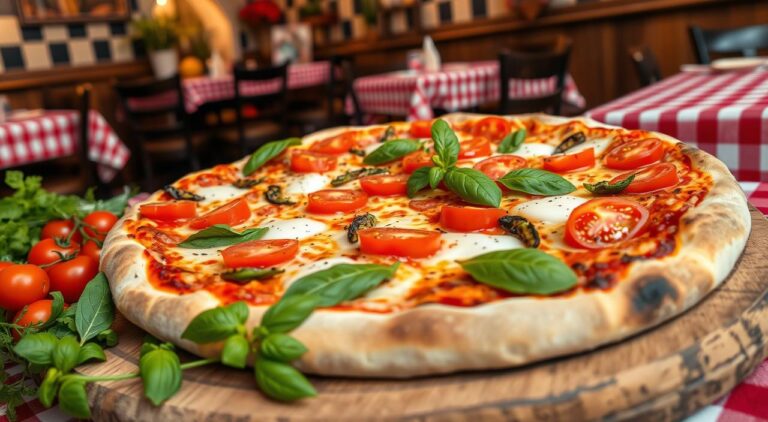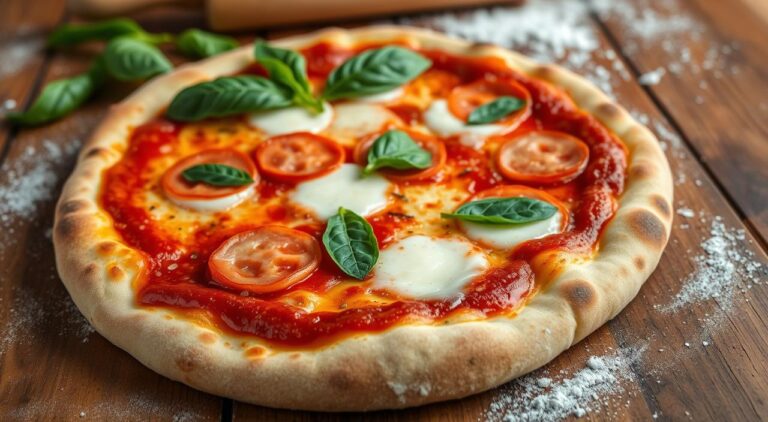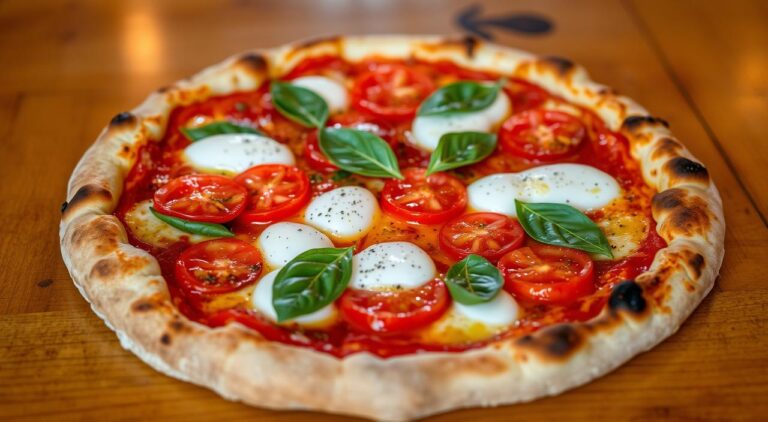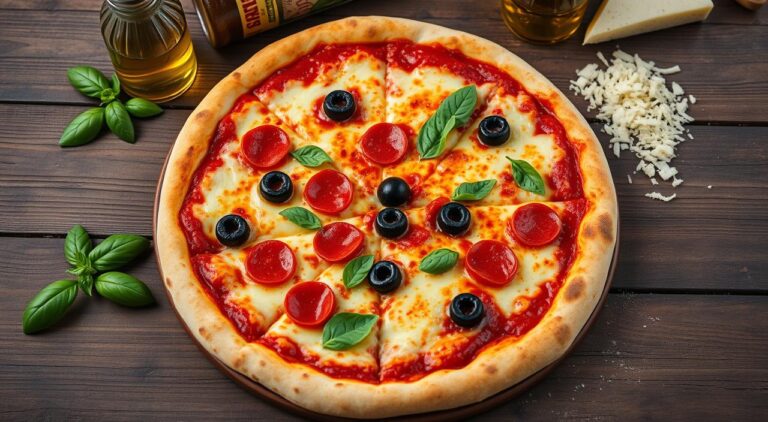Get ready for a food journey that mixes rasta pasta, Jamaican cuisine, and jerk seasoning. This dish combines Caribbean boldness with Italian comfort, creating a taste experience like no other.
The Rastafarian movement is at the core of this dish. It’s a blend of culture and spirituality that has shaped the food world. Exploring rasta pasta means diving into the stories of dreadlocks hairstyles, reggae music, and ganja culture.
Rasta pasta is a mix of flavors and cultures in every bite. It’s a celebration of diversity and creativity. It shows how different things can come together to create something amazing.
Exploring the Vibrant Flavors of Rasta Pasta
Rasta pasta comes from the mix of Jamaican cuisine and Italian cooking. It’s a dish that brings together the spicy taste of jerk seasoning with the creamy feel of pasta. This blend creates a unique taste experience.
Uncovering the Roots of This Unique Culinary Blend
The story of rasta pasta starts with the lively Caribbean flavors of Jamaican food. Spices like allspice, thyme, and Scotch bonnet peppers give it a fiery and aromatic taste. This mix of cultures shows the creativity of Caribbean cooking.
Key Ingredients That Define Rasta Pasta’s Distinctive Taste
- Jerk seasoning: A mix of spices, herbs, and peppers that add a bold, smoky, and spicy kick to the dish.
- Allspice: A fragrant spice that lends a warm, slightly sweet, and slightly peppery flavor.
- Thyme: An aromatic herb that enhances the overall savory notes.
- Scotch bonnet peppers: Fiery and flavorful peppers that bring the heat to rasta pasta.
- Pasta: The comforting and creamy foundation that balances the robust Caribbean flavors.
These ingredients come together to create a flavor mix that embodies rasta pasta and its special cooking history.
The Rastafarian Movement and Its Influence on Cuisine
The Rastafarian movement started in Jamaica and has changed the island’s food ways. Followers of Haile Selassie I blend their beliefs with their cooking. They use natural ingredients and add symbols like the Rastafarian flag’s colors to their meals.
Rastafarian food focuses on natural, plant-based foods. They often eat vegetarian or vegan, using ital (unprocessed foods) and local produce. Ganja (marijuana) is also part of their culture, seen in some Rasta Pasta recipes.
“Rastafarian cuisine is not just about the food – it’s a way of life, a connection to the land and a celebration of the Zion culture.”
The Rastafarian flag’s colors, red, gold, and green, show up in Rasta Pasta dishes. These colors symbolize the movement’s culture and beliefs.
Rastafarian cooking has spread worldwide, making Rasta Pasta popular globally. This shows how the Rastafarian philosophy has touched food culture worldwide.
Jerk Seasoning: The Fiery Heart of Caribbean Flavors
Jamaican cuisine is known for its bold jerk seasoning. This blend of spices brings a fiery and aromatic taste to many dishes. When used in rasta pasta, it creates a perfect mix of Caribbean and Italian flavors.
Traditional Recipes and Modern Twists
The traditional jerk seasoning mix includes allspice, thyme, and Scotch bonnet peppers. Over time, it has seen many new versions. These new takes add more flavors and suit different tastes.
Some popular modern jerk seasoning recipes include:
- Jerk seasoning with a touch of brown sugar for a slightly sweet and caramelized finish
- Versions that blend jerk spices with citrus notes, such as lime or orange, for a bright and zesty flavor profile
- Variations that incorporate smoked paprika or chipotle powder to add a subtle smoky undertone
“The essence of Jamaican jerk seasoning is its ability to transport your taste buds to the heart of the Caribbean flavors.”
The core of jerk seasoning stays the same, no matter the recipe. It’s a mix of savory, spicy, and aromatic flavors. These are key to Jamaican cuisine and the popular rasta pasta dish.

Dreadlocks and Reggae: The Cultural Significance
The dreadlocks hairstyle and reggae music are closely linked with the Rastafarian movement. They have greatly shaped how people see and experience rasta pasta.
The dreadlocks hairstyle shows the Rastafarian’s bond with their African roots. It stands for the movement’s beliefs and its push against Western beauty norms.
Reggae music is a key part of Rastafarian culture. Its tunes and lyrics talk about important values like social justice and spiritual growth. These values are also found in rasta pasta.
“Rasta pasta is not just a dish; it’s a cultural experience that celebrates the rich heritage of the Rastafarian movement.”
Hairstyles and Music Intertwine with Rasta Pasta
Dreadlocks and reggae are more than just looks or sounds. They are symbols of the Rastafarian way of life. When you eat rasta pasta, you’re not just tasting a mix of Caribbean and Italian flavors. You’re also diving into the culture that made this dish special.
- The dreadlocks hairstyle shows the Rastafarian’s link to their African heritage and their defiance of Western beauty standards.
- Reggae music mirrors the Rastafarian’s spiritual views and their fight for social justice.
- Together, dreadlocks and reggae music form a cultural fabric that’s a big part of rasta pasta.
Rasta Pasta: A Fusion of Cultures on a Plate
Rasta pasta is a dish that brings together the lively Caribbean flavors and the cozy Italian cuisine. It mixes the spicy, aromatic Jamaican jerk seasoning with creamy pasta. This creates a meal that celebrates cultural diversity.
This dish combines the bold Jamaican cuisine with the classic Italian cuisine. It shows how both traditions can adapt and grow together. It invites diners on a journey of new tastes that go beyond borders.
“Rasta pasta is a culinary masterpiece that celebrates the dynamic interplay of cultures, proving that the fusion of diverse culinary influences can give rise to something truly extraordinary.”
The dish’s bright colors and strong spices make it a feast for the senses. It’s a mix of Caribbean flavors in a classic pasta dish. This blend of Jamaican and Italian tastes creates a unique dining experience.
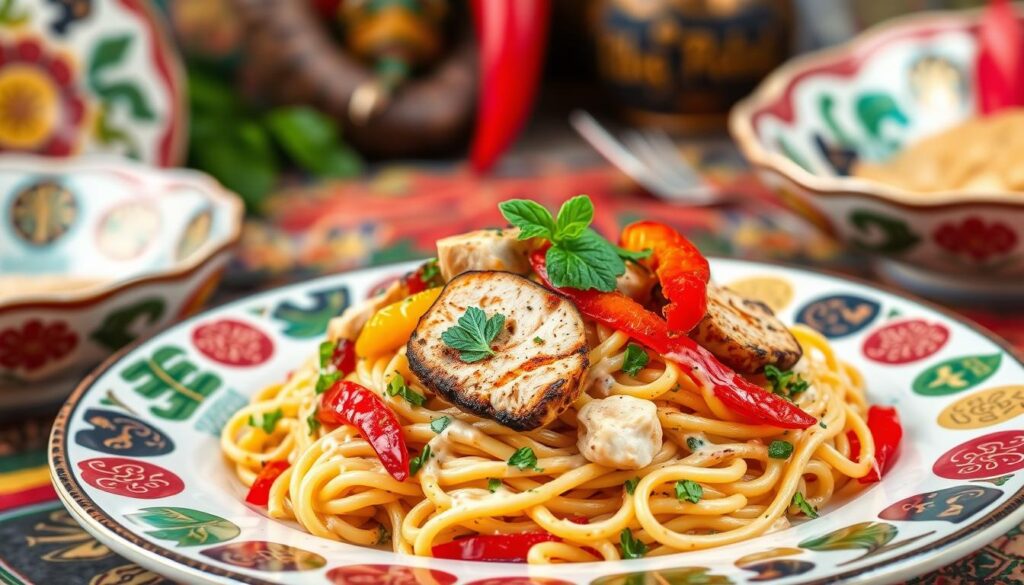
Rasta pasta shows how creativity in the kitchen can bring different cultures together. It’s a dish that combines Jamaican cuisine and Italian cuisine. It encourages diners to see the beauty in cultural exchange through food.
Zion Culture: Embracing the Rastafarian Lifestyle
The rastafarian movement has changed how we see and enjoy rasta pasta. Zion culture is all about the spiritual and physical home of Rastafarians. It’s about using natural ingredients and living a holistic life. This idea is seen in rasta pasta, where we use fresh, local ingredients and celebrate different cultures.
Zion culture values nature and living in harmony with the earth. Rastafarians try to live by this in their daily lives, including their cooking. Rasta pasta shows this by using many colorful, plant-based ingredients. These are chosen and prepared to highlight their natural tastes and health benefits.
The Rastafarian movement also adds a spiritual and emotional layer to eating rasta pasta. For many, cooking and sharing meals is a way to connect with the divine and celebrate unity. This is seen in how we enjoy rasta pasta, focusing on being mindful, thankful, and appreciating the cultural mix that made it.
“Rasta pasta is more than just a dish; it’s a celebration of the Rastafarian way of life, a fusion of flavors that nourishes the body and the soul.”
By embracing Zion culture and the Rastafarian lifestyle, we can better understand and value rasta pasta. It shows the movement’s key values: unity, spirituality, and a deep respect for nature.
Ganja Culture: Marijuana References in Rasta Pasta
The Rastafarian movement has always linked to marijuana, also known as ganja. This has shaped the culture of rasta pasta. Even though using marijuana is debated, its symbolic value in the movement is clear.
Exploring the Controversial Symbolism
Rasta pasta might hint at this part of Rastafarian culture, but it doesn’t have any cannabis. The link between ganja and rasta pasta comes from the Rastafarian movement’s history. They’ve always seen marijuana as sacred and spiritual.
The Rastafarian community believes marijuana helps with personal growth, spiritual insight, and connecting with nature. This belief has shaped their culture, including their food, like rasta pasta.
“Ganja has long been an integral part of the Rastafarian lifestyle, and its influence can be seen in the symbolism and aesthetics that permeate rasta pasta.”
Discussing marijuana in rasta pasta can be tricky, but it’s key to see its cultural and historical importance. Knowing about ganja culture and its role in Rastafarianism helps us enjoy this unique dish more.
- The Rastafarian movement’s association with the use of marijuana, known as ganja, has influenced the cultural context of rasta pasta.
- Rasta pasta may incorporate subtle nods to this aspect of Rastafarian culture, though the dish itself does not contain any cannabis-derived ingredients.
- The connection between ganja culture and rasta pasta lies in the shared roots of the Rastafarian movement, which has long revered the use of marijuana as a sacred and spiritual practice.
Cooking Tips and Techniques for Mastering Rasta Pasta
Making the perfect rasta pasta is all about balancing flavors and techniques. To get it right, you need to cook the pasta just until it’s al dente. Also, blend the jerk seasoning and other spices into a creamy sauce that’s full of flavor.
Using fresh, high-quality ingredients is key in rasta pasta. The pasta should be cooked until it’s firm but still a bit chewy. This way, it can soak up the sauce well. The jerk seasoning, made from allspice, thyme, and scotch bonnet peppers, must be added carefully to the sauce. This gives the dish its unique taste.
- Start by boiling the pasta in salted water until it reaches the desired al dente texture, usually around 8-10 minutes.
- In a separate pan, sauté onions, garlic, and bell peppers in a high-quality olive oil to release their aromatic compounds.
- Add the jerk seasoning and let it toast for a minute or two, allowing the spices to bloom and infuse the oil.
- Deglaze the pan with a splash of white wine or vegetable broth, scraping up any browned bits from the bottom.
- Stir in heavy cream or coconut milk, and let the sauce simmer and thicken to a creamy consistency.
- Drain the pasta and add it directly to the sauce, tossing gently to coat each strand.
- Garnish with fresh herbs, such as cilantro or scallions, and a sprinkle of Parmesan cheese for an extra touch of flavor.
By following these tips and techniques, you’ll be well on your way to mastering the art of rasta pasta. You’ll create a dish that’s full of flavor and celebrates the mix of Caribbean and Italian cuisines.
Rasta Pasta: A Celebration of Diversity and Creativity
Rasta pasta brings together the best of Caribbean and Italian cooking. It’s a dish that celebrates diversity and creativity. It mixes the spicy flavors of Jamaican cuisine with the creamy taste of Italian cuisine.
This dish shows how different cultures can come together through food. By adding jerk spices to pasta, rasta pasta proves that food can bridge cultural gaps. It’s a sign of how exploring new tastes can bring people together.
“Rasta pasta is a celebration of the diversity that makes our world a more vibrant and interesting place. It’s a delicious reminder that when we embrace cultural exchange, we open ourselves up to a world of culinary possibilities.”
Chefs and home cooks can use rasta pasta to mix Caribbean flavors with Italian cuisine. This creates a dish that’s not just tasty but also a symbol of unity.
If you love food or just want to try new things, rasta pasta invites you on a tasty journey. It’s a dish that celebrates cultural fusion. So, get your ingredients ready, start cooking, and let this dish take you to a place where diversity and creativity meet in the kitchen.
Conclusion: Embracing the Fusion of Cultures
Rasta pasta is a dish that brings together Caribbean and Italian flavors in a unique way. It combines the bold taste of Jamaican jerk seasoning with the creamy texture of Italian pasta. This mix creates a taste experience that is both new and exciting.
This dish shows how different culinary traditions can come together. It invites you to try something new and enjoy the blend of rasta pasta, caribbean flavors, jamaican cuisine, italian cuisine, and cultural fusion. It’s a dish that pleases the taste buds and highlights the creativity that comes from mixing different foods.
Trying rasta pasta is like going on a taste adventure. It celebrates the mix of flavors and traditions that make this dish special. It proves that food can bring people together, creating something new and delicious that we all can enjoy.



